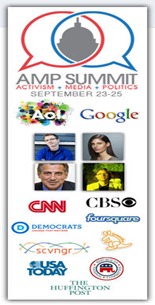 If my own and the @bivings tweets hasn’t already tipped you off, I was fortunate to spend last Friday and Saturday at the inaugural AMP Summit. Organized by our friends at the David All Group and a distinguished leadership committee including Joe Trippi, Jerome Armstrong, Robert Bluey, Peter Corbett, Peter Greenberger, Todd Herman, Bruce Mehlman, Leslie Sanchez and Jonah Seiger, the AMP Summit built on the successes of several conferences related to technology, politics and government.
If my own and the @bivings tweets hasn’t already tipped you off, I was fortunate to spend last Friday and Saturday at the inaugural AMP Summit. Organized by our friends at the David All Group and a distinguished leadership committee including Joe Trippi, Jerome Armstrong, Robert Bluey, Peter Corbett, Peter Greenberger, Todd Herman, Bruce Mehlman, Leslie Sanchez and Jonah Seiger, the AMP Summit built on the successes of several conferences related to technology, politics and government.
In terms of critiquing the AMP Summit, David All and his team deserve a lot of credit for effectively managing and mitigating many of the little things that irritate frequent conference goers / networking junkies. In short, it is obvious that the organizers of the AMP Summit made a decision not to cut corners and put a great deal of thought into making the experience of attendees as smooth as possible. The organization of breakout sessions into four separate tracks (Activism-Media-Politics-Lab) and categorization of panels by their focus (Case Study, How-To, Thought) was generally accurate and useful for attendees to determine their schedules.
The speakers were all subject matter experts who delivered interesting presentations while also leaving more time for Q&A than you typically see. The lunch hour and 30 minute breaks between panels provided for plenty of time to talk to presenters, network with other attendees or catch up on work emails without feeling the need to dash off to your next event. Rather than trying to cram as much as possible into the summit, there was a clear focus on quality instead of quantity. The location was easily accessible via public transportation and the conference took place in a reserved area of the hotel. The food was excellent and the Starbucks coffee was kept warm and flowing all day. Networking receptions and choice of locations was absolutely fantastic (iPad DJ @ranajune rocks!).
On the minus side, having the second day take place on a Saturday was something many attendees did not commit too. However, the smaller crowd made for more intimate discussions with panelists and even better networking among those who stayed around. Although it technically made for a 6 day work week, it is tough to imagine a better or more productive way to spend your Saturday afternoon.
Other areas for improvement include the ever vexing problem of providing quality Wi-Fi that can handle
hundreds of high bandwidth users. For next year’s AMP Summit, having the ability to connect your Facebook & Twitter accounts in order to create & share your schedule (SCHED in DC Week) and then network and connect with other attendees (Gov 2.0 Attendee Directory) would be truly valuable. Finally for those of us who live-tweet these events, having the speakers’ Twitter handles ahead of time and the presentations to view afterwards would be a big timesaver.
All in all, AMP was a good and welcome entrance to the world of technology conferences. Just like no one individual or organization has a monopoly on the internet, no one brand or organization has a monopoly on tech conferences. As an added bonus, AMP was wise to create hype for next year by awarding prior attendees with “Level 2” privileges next year.
For more on AMP check out the conference blog & Facebook Page and OhMyGov’s recap “The AMP Summit in 50 Tweets.”
Sign up today to have our latest posts delivered straight to your inbox.